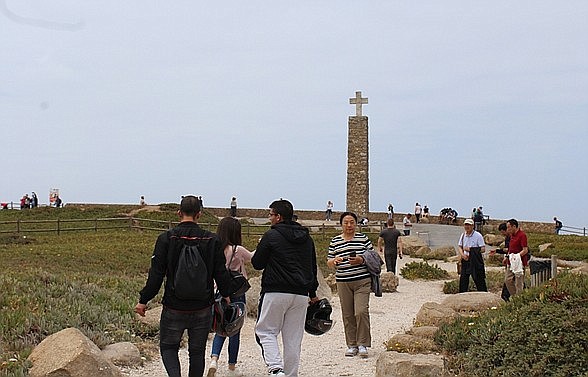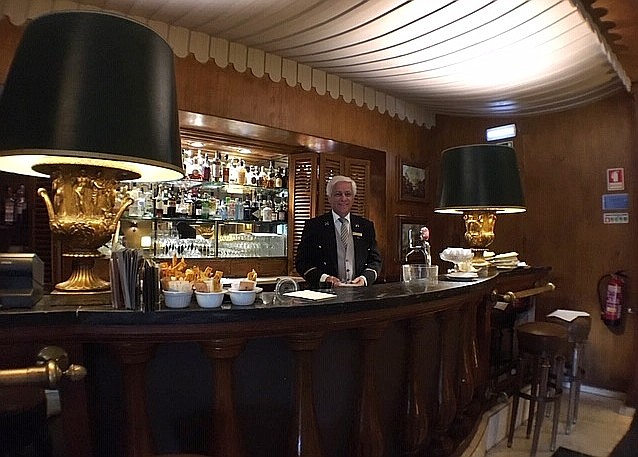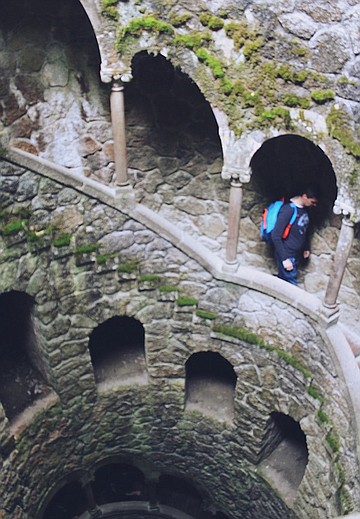 Facebook
Facebook
 X
X
 Instagram
Instagram
 TikTok
TikTok
 Youtube
Youtube

Portugal has a long, rich history that colors everything from its language, food and architecture. It was settled by homo sapiens 35,000 years ago and retains traces of a non–Indo European language and even DNA. They were invaded by the Celts, Romans and Moors, but have the oldest national borders in all of Europe — even older than Spain.
I could pick out cognates when reading menus, having a handle on French and exposure to Spanish and Italian. But hearing Portuguese, I was lost! There are lots of "x" and "sh" consonants: it sounded more Middle Eastern to me.
Portuguese sailors started exploring the globe as early as the 1300s, establishing commerce and sometimes colonies in Africa, India, Asia, Brazil and even what is now maritime Canada, where they found rich stocks of their beloved cod fish, which is not available in Portugal. Their outposts added exotic spices and pepper, along with tropical fruits, sugar and tea to their national cuisine first in Europe.
Portugal was officially neutral during WWII, though they secretly gave great assistance to the Allied forces. During the war, the Atlantic Coast hosted officers, diplomats and spies from all around the world, from all sides.
Even today, it’s understandable, with the usually very pleasant weather, bounty of seafood and wines of all sorts, how they attract those who enjoy fine living from across Europe. Lots of deposed or exiled royals from places like France, Italy and Bulgaria reside here both part and full time. But here’s the thing: though there are upscale places to eat and stay, you can wear nice resort wear anywhere. It’s Europe, there are nice European cars around, but nothing comes off like the Grey Poupon ad. There doesn’t seem to be in-your-face crass consumerism. So, you could easily be drinking a glass of wine next to the guy with the best claim to be King of France and not even know it.
Hotel Quinta da Marinha Resort is in Cascais, about 20 minutes from Lisbon, as well as the airport and just a few minutes from the historic port, filled with restaurants and fun. They have amenities that Americans would love: big, king-sized beds, deep tubs, showers, indoor and outdoor pools, sauna and spa, along with a Robert Trent Jones golf course featuring views of the Atlantic Ocean and the Sintra mountains.
They also quietly have a fabulous mixology bar! Carousels of fresh flowers, exotic spices, dried fruits and even pinecones are brûléed to enhance classic cocktails with a cutting-edge twist.
Between the oceans, the vineyards, ancient cultures and proud traditions, every meal I ate had its own charm. Most classic Portuguese desserts have a convent or monastic origin. One of the most copied and storied of these made its secular debut at Pasteis de Belem in 1837.
After religious orders were shut down by the government in 1834, former members of a monastery next door to a sugar refinery offered to sell products made with their secret treasured recipe. Like other similar sweets created by the monks and nuns, they’re from simple ingredients like eggs, combined with the spices that Portuguese explorers discovered around the world. The famous pastry is the same as it was nearly 200 years ago: a rich custard brûléed into a tender crust. Espresso cuts through the cream and sugar flavors perfectly. One of the terrific buys of the century are their little espresso sets for just a few euros.
The founder of continental Europe’s most western vineyard, Casal Sta. Maria — Baron Bodo von Bruemmer — was not only a bon vivant, he was a long vivant. Told in his 50s and again in his mid-90s that he was living on borrowed time with cancer, this successful banker and racing horse expert decided to fulfill his dream of making wine in a beautiful place. There must be something to seizing life by the horns: he lived to the age of 105. Colares, Portugal, has an interesting micro-climate — being on a bluff in the far western part of the country, near the Atlantic Ocean — contributing to crisp wines. Did you think Portugal only put out port?
There’s a restaurant right on the Atlantic Ocean that’s been beloved by generations of Portuguese families for 30 years: Cascais’ Panorama Guincho. In a country rich with ocean and river seafood, they’ve been voted “Best seafood in Portugal”. It’s also been recognized by Michelin. Their fish is caught in the Atlantic Ocean. That means they don’t serve anything from aquaculture farmed.
Something that visiting families order for the table — and you should, too — is the whole baked-in-bread sea bass. It's their rare specialty: they bake a thin layer of braided bread around the fish until it’s really crispy. The fish inside keeps so juicy! It’s a clean, mild, flaky fish that is beloved by people young and old. They present it with gravy boats of herbed olive oil, a Hollandaise and a remoulade. Also, a bottle of local rich olive oil is available to really keep things simple but luscious. And yes, you eat the bread, too.
In 1865, Portugal began its canning industry, the country’s oldest industry. You can tell it’s beloved by the nation by just going through Lisbon’s airport: there are cans upon cans of seafood for sale at the duty-free shops, extending to last-minute carts right before the gates.
Now there’s a restaurant that celebrates the canning industry: Can the Can elevates the often gourmet selections grown, fished and created in Portugal. What really caught my attention was the presentation, texture and color of their canned seafood. I’m so used to mushy, gushy tuna in the US. One Portuguese favorite, escabeche, incorporates sardines, baby eels and homemade pickles, seasoned with cumin, parsley and fennel. It’s meant to recall memories of marinated fried fish in taverns.
During WWII, high-level spies stayed at Palacio Estoril hotel right on the Atlantic Ocean. The author of the James Bond series, Ian Fleming, was himself a British naval intelligence officer, staying at the hotel under the guise of being a writer. With the casino right next door, many spies had to act as gentlemen of leisure, with no visible means — or need — for support. The James Bond movie On Her Majesty’s Secret Service was filmed on site. A couple of actors in the film still work at the Palacio Estoril, including Jose’ Diogo Vieira, now the Deputy (in semi-retirement) Head Concierge. I got to meet him – he’s definitely a silver fox.

Feel like you're the capstone on an arch overlooking Lisbon: for just a few dollars, take an elevator – then climb spiral stairs – to the top of Rua Augusta Arch. It was built to commemorate their rebuilding after the 1755 earthquake and tsunami. You can get right next to gorgeous sculptures while checking out the harbor and creating awesome selfies. Can the Can and The Sexiest WC on Earth are in plain view. What? Yes, a European personal hygiene company has turned going to the toilet into an attraction. After you pay your admission fee and pass through the gift shop (!), you pick out a roll for your own use.

What color to pick? I kinda didn’t want to overthink it. It was bad enough that I was standing around, taking photos. The space is low-lit, with sexy photos... for romance?
It's definitely fun to take one of the speedboat (or other boat) trips along to coastline and helps get your bearings.
Put on your sturdiest walking shoes to go to the mountains and check out historic Sintra, but don’t bother driving. With the complete lack of public parking, the medieval roads and crowds, you’ll spend all day looking for a spot. Instead, hire a nimble and experienced guide like those at Short Cuts Tourism. Fortify yourself with an espresso and mini egg custard pie beloved by royalty at the historic Piriquita bakery and check out the well-stocked souvenir shops in the town square. Then, start hiking: you’ll see everything from Moorish palaces to Renaissance estates and Baroque-era cottages.

A grand and mysterious property on top of one of the hills is now an attraction open to the public: the Quinta da Regaleira. Built on aristocratic land by a very odd millionaire who was so rich that he could do no wrong in the eyes of fellow social-climbing industrialists, he created a Neo-Gothic palace to better indulge his interests in alchemy, the Knights Templar, the Masons and the Rosicrucians. He created a dark, tight stone spiral “initiation well” that’s 89 feet deep. I can’t believe I made it down all the way.The well leads to several secret grottoes, passageways and huge garden labyrinths.
Afterwards, there is a stone fountain that pours out water that’s said to make you rich. Nobody else was drinking out of it, but since I had made it out of the bowels of the well, I wasn’t afraid to try my hand at being rich.
If you go: Visit Portugal website, Flytap.com.


Portugal has a long, rich history that colors everything from its language, food and architecture. It was settled by homo sapiens 35,000 years ago and retains traces of a non–Indo European language and even DNA. They were invaded by the Celts, Romans and Moors, but have the oldest national borders in all of Europe — even older than Spain.
I could pick out cognates when reading menus, having a handle on French and exposure to Spanish and Italian. But hearing Portuguese, I was lost! There are lots of "x" and "sh" consonants: it sounded more Middle Eastern to me.
Portuguese sailors started exploring the globe as early as the 1300s, establishing commerce and sometimes colonies in Africa, India, Asia, Brazil and even what is now maritime Canada, where they found rich stocks of their beloved cod fish, which is not available in Portugal. Their outposts added exotic spices and pepper, along with tropical fruits, sugar and tea to their national cuisine first in Europe.
Portugal was officially neutral during WWII, though they secretly gave great assistance to the Allied forces. During the war, the Atlantic Coast hosted officers, diplomats and spies from all around the world, from all sides.
Even today, it’s understandable, with the usually very pleasant weather, bounty of seafood and wines of all sorts, how they attract those who enjoy fine living from across Europe. Lots of deposed or exiled royals from places like France, Italy and Bulgaria reside here both part and full time. But here’s the thing: though there are upscale places to eat and stay, you can wear nice resort wear anywhere. It’s Europe, there are nice European cars around, but nothing comes off like the Grey Poupon ad. There doesn’t seem to be in-your-face crass consumerism. So, you could easily be drinking a glass of wine next to the guy with the best claim to be King of France and not even know it.
Hotel Quinta da Marinha Resort is in Cascais, about 20 minutes from Lisbon, as well as the airport and just a few minutes from the historic port, filled with restaurants and fun. They have amenities that Americans would love: big, king-sized beds, deep tubs, showers, indoor and outdoor pools, sauna and spa, along with a Robert Trent Jones golf course featuring views of the Atlantic Ocean and the Sintra mountains.
They also quietly have a fabulous mixology bar! Carousels of fresh flowers, exotic spices, dried fruits and even pinecones are brûléed to enhance classic cocktails with a cutting-edge twist.
Between the oceans, the vineyards, ancient cultures and proud traditions, every meal I ate had its own charm. Most classic Portuguese desserts have a convent or monastic origin. One of the most copied and storied of these made its secular debut at Pasteis de Belem in 1837.
After religious orders were shut down by the government in 1834, former members of a monastery next door to a sugar refinery offered to sell products made with their secret treasured recipe. Like other similar sweets created by the monks and nuns, they’re from simple ingredients like eggs, combined with the spices that Portuguese explorers discovered around the world. The famous pastry is the same as it was nearly 200 years ago: a rich custard brûléed into a tender crust. Espresso cuts through the cream and sugar flavors perfectly. One of the terrific buys of the century are their little espresso sets for just a few euros.
The founder of continental Europe’s most western vineyard, Casal Sta. Maria — Baron Bodo von Bruemmer — was not only a bon vivant, he was a long vivant. Told in his 50s and again in his mid-90s that he was living on borrowed time with cancer, this successful banker and racing horse expert decided to fulfill his dream of making wine in a beautiful place. There must be something to seizing life by the horns: he lived to the age of 105. Colares, Portugal, has an interesting micro-climate — being on a bluff in the far western part of the country, near the Atlantic Ocean — contributing to crisp wines. Did you think Portugal only put out port?
There’s a restaurant right on the Atlantic Ocean that’s been beloved by generations of Portuguese families for 30 years: Cascais’ Panorama Guincho. In a country rich with ocean and river seafood, they’ve been voted “Best seafood in Portugal”. It’s also been recognized by Michelin. Their fish is caught in the Atlantic Ocean. That means they don’t serve anything from aquaculture farmed.
Something that visiting families order for the table — and you should, too — is the whole baked-in-bread sea bass. It's their rare specialty: they bake a thin layer of braided bread around the fish until it’s really crispy. The fish inside keeps so juicy! It’s a clean, mild, flaky fish that is beloved by people young and old. They present it with gravy boats of herbed olive oil, a Hollandaise and a remoulade. Also, a bottle of local rich olive oil is available to really keep things simple but luscious. And yes, you eat the bread, too.
In 1865, Portugal began its canning industry, the country’s oldest industry. You can tell it’s beloved by the nation by just going through Lisbon’s airport: there are cans upon cans of seafood for sale at the duty-free shops, extending to last-minute carts right before the gates.
Now there’s a restaurant that celebrates the canning industry: Can the Can elevates the often gourmet selections grown, fished and created in Portugal. What really caught my attention was the presentation, texture and color of their canned seafood. I’m so used to mushy, gushy tuna in the US. One Portuguese favorite, escabeche, incorporates sardines, baby eels and homemade pickles, seasoned with cumin, parsley and fennel. It’s meant to recall memories of marinated fried fish in taverns.
During WWII, high-level spies stayed at Palacio Estoril hotel right on the Atlantic Ocean. The author of the James Bond series, Ian Fleming, was himself a British naval intelligence officer, staying at the hotel under the guise of being a writer. With the casino right next door, many spies had to act as gentlemen of leisure, with no visible means — or need — for support. The James Bond movie On Her Majesty’s Secret Service was filmed on site. A couple of actors in the film still work at the Palacio Estoril, including Jose’ Diogo Vieira, now the Deputy (in semi-retirement) Head Concierge. I got to meet him – he’s definitely a silver fox.

Feel like you're the capstone on an arch overlooking Lisbon: for just a few dollars, take an elevator – then climb spiral stairs – to the top of Rua Augusta Arch. It was built to commemorate their rebuilding after the 1755 earthquake and tsunami. You can get right next to gorgeous sculptures while checking out the harbor and creating awesome selfies. Can the Can and The Sexiest WC on Earth are in plain view. What? Yes, a European personal hygiene company has turned going to the toilet into an attraction. After you pay your admission fee and pass through the gift shop (!), you pick out a roll for your own use.

What color to pick? I kinda didn’t want to overthink it. It was bad enough that I was standing around, taking photos. The space is low-lit, with sexy photos... for romance?
It's definitely fun to take one of the speedboat (or other boat) trips along to coastline and helps get your bearings.
Put on your sturdiest walking shoes to go to the mountains and check out historic Sintra, but don’t bother driving. With the complete lack of public parking, the medieval roads and crowds, you’ll spend all day looking for a spot. Instead, hire a nimble and experienced guide like those at Short Cuts Tourism. Fortify yourself with an espresso and mini egg custard pie beloved by royalty at the historic Piriquita bakery and check out the well-stocked souvenir shops in the town square. Then, start hiking: you’ll see everything from Moorish palaces to Renaissance estates and Baroque-era cottages.

A grand and mysterious property on top of one of the hills is now an attraction open to the public: the Quinta da Regaleira. Built on aristocratic land by a very odd millionaire who was so rich that he could do no wrong in the eyes of fellow social-climbing industrialists, he created a Neo-Gothic palace to better indulge his interests in alchemy, the Knights Templar, the Masons and the Rosicrucians. He created a dark, tight stone spiral “initiation well” that’s 89 feet deep. I can’t believe I made it down all the way.The well leads to several secret grottoes, passageways and huge garden labyrinths.
Afterwards, there is a stone fountain that pours out water that’s said to make you rich. Nobody else was drinking out of it, but since I had made it out of the bowels of the well, I wasn’t afraid to try my hand at being rich.
If you go: Visit Portugal website, Flytap.com.
Comments